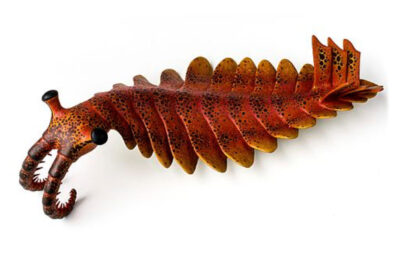 Anomalocaris, an ancient three-foot-long shrimp-like creature, is an evolution anomaly. Anomalocaris (pictured left) is Greek for “anomaly shrimp.”
Anomalocaris, an ancient three-foot-long shrimp-like creature, is an evolution anomaly. Anomalocaris (pictured left) is Greek for “anomaly shrimp.”
The origin of this marine creature’s compound eye, a species first discovered by Charles Doolittle Walcott in the Canadian Rockies at an elevation of over 7,000 feet above sea level, has long puzzled evolution scientists. Where did the freakish eyes originate, and how did it end up in the Canadian Rockies?
Top predators have exceptional vision, freakish or not. This week a team of scientists from Australia and Spain led by John R. Paterson (pictured right), a paleontologist at the University of New England, reported on a fossilized Anomalocaris’s compound eye found in the Emu Bay Shale, South Australia. The focus of the study was to explore the ancestral origins of Anomalocaris’s freakish eye.
Study Findings
Their study, entitled “Acute vision in the giant Cambrian predator Anomalocaris and the origin of compound eyes,” was published in the December 8 edition of the journal Nature. This underwater sea creature, a  seeming freak of evolution with bizarrely structured compound eyes at the end of two stalks, is unlike any other known counterpart, past or present. As Paterson explains –
seeming freak of evolution with bizarrely structured compound eyes at the end of two stalks, is unlike any other known counterpart, past or present. As Paterson explains –
“Their preserved visual surfaces are composed of at least 16,000 hexagonally packed ommatidial lenses (in a single eye), rivaling the most acute compound eyes in modern arthropods.”
Paterson proposed that Anomalocaris’s compound eyes had emerged from a “single-origin.” Paterson explains –
“The structure and development of ommatidia [radial element] in arthropod compound eyes support a single-origin sometime before the latest common ancestor of crown-group arthropods.
The study, however, could not find evidence to support the “single-origin” theory. As Paterson notes –
“Anomalocaris is the stuff of nightmares” – at least for an evolution scientist.
Pete Spotts, a staff writer for The Christian Science Monitor, noted in the article entitled “Jeepers, creepers, where did the Cambrian ocean’s top predator get those peepers?” present the challenge for evolution scientists –
“The presence of these eyes at this stage in the evolution of life on Earth indicates how quickly, in geologic time, novel features can emerge.”
Corroborating evidence to support the “single origin” theory by studying Anomalocaris’s compound eye was a bust; the team could not identify any transitional eye elements. In an interview with Michael Marshall writing for the New Scientist, Paterson noted –
“Very few modern animals, particularly arthropods, have eyes as sophisticated as this.”
In an interview with Paterson, Matt Kaplan, science writer for Nature News, in the article entitled “An eye-opening fossil. Ancient predators had vision sharper than modern insects,” Paterson said regarding the 16,000 lenses on each eye,
“This is a lot. The common housefly has only 3,200, and most ants have fewer than 1,000.”
“Such lens-rich compound eyes,” Paterson continued, “suggest Anomalocaris was a highly visual hunter. Its prey didn’t stand a chance.”
 Robert Gaines (pictured left), a palaeobiologist at Pomona College in Claremont, California, in an interview with Kaplan, understates the implications of the study findings –
Robert Gaines (pictured left), a palaeobiologist at Pomona College in Claremont, California, in an interview with Kaplan, understates the implications of the study findings –
“This could stir up a debate.”
An ancestral origin for Anomalocaris’s compound eyes had no known traceable origin. The Paterson team concluded –
“Functional morphological arguments from the structure of raptorial frontal appendages and large, spherical eyes in various Cambrian arthropods indicate that visual predation in the water column was already established as an important component in early Cambrian food webs.”
Unexpectedly, rather than identifying a “single-origin,” the research team found fossil record evidence that the origin of Anomalocaris’s compound eye was “already established” – there are no evolutionary forerunners.
The Origin of Species
As a proposed scientific theory, Charles Darwin proposed the following falsification test in The Origin of Species –
“If it could be demonstrated that any complex organ exists which could not possibly have been formed by numerous, successive, slight modifications, my theory would absolutely break down.”
Since the Anomalocaris’s compound eye was “already established,” without any known natural origin, Darwin’s theory of evolution is, therefore, falsified. Darwin also included another falsification test –
“If numerous species, belonging to the same genera or families, have really started into life at once, the fact would be fatal to the theory of evolution through natural selection.”
Darwin’s dilemma intensifies.
Genesis
Paterson’s evidence obtained studying the Anomalocaris’s compound eye falsifies Darwin’s theory of evolution “by means of natural selection.” 
Anomalocaris’s compound eye as an “already established as an important component in the early Cambrian” era, is compatible with the Genesis account written by Moses.
Louis Pasteur (pictured right), a French chemist and microbiologist, discovered the principles of vaccination, microbial fermentation, and pasteurization noted during the Scientific Revolution –
“There is something in the depths of our souls which tells us that the world must be more than a mere combination of events.”
Refer to the Glossary for the definition of terms and to Understanding Evolution to gain insights into understanding evolution.
2020 Update
In terms of evolution, Includes only the work of Pateron’s team in 2011.
“In 2011, six fossils of compound eyes, the first for Anomalocaris, were recovered from a paleontological dig at Emu Bay on Kangaroo Island, Australia, proving that Anomalocaris was indeed an arthropod as had been suspected. The find also indicated that advanced arthropod eyes had evolved very early, before the evolution of jointed legs or hardened exoskeletons.”
“Based on fossilized eyes from the Emu Bay Shale, which belonged to Anomalocaris briggsi (Which, based on morphological and phylogenetic evidence, was more closely related to Tamisiocaris), the eyes of Anomalocaris were 30 times more powerful than those of trilobites, long thought to have had the most advanced eyes of any contemporary species. With 16,000 lenses, the resolution of the 3-centimetre-wide (1.2 in) eyes would have been rivaled only by that of the modern dragonfly, which has 28,000 lenses in each eye. Additionally, Anomalocaris had a dichromatic colour vision.”
Evolution 101 website does not include any discussion of Anomalocaris.
The Smithsonian Museum website does not include any discussion of Anomalocaris.

